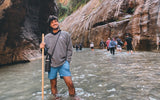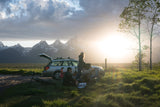Exploring Colorado: A Look Inside Rocky Mountain National Park

Contributed by Sophie Goodman; top photo by Skeeze (Pixabay)
Rocky Mountain National Park, a breathtaking 415-square mile National Park located just west of Colorado’s Front Range, is an American icon. Jagged peaks soar above alpine lakes, elk herds graze in mountain meadows, and wildflowers takeover the grasslands in summer.
Humans have roamed Rocky Mountain National Park land since the glaciers began to retreat in 10,000 BCE. Archeological artifacts like arrowheads have informed researchers about ancestral hunter-gathers of Western Native American tribes such as the Ute, Arapaho, and Apache. The two roads that run through the National Park today—Fall River Road and Trail Ridge Road—follow the ancient routes that these native peoples used to cross the mountains.
There are more than 600 historic buildings standing in Rocky Mountain National Park today. Some buildings pre-date the 1915 establishment of the National Park, but most are the remnants of ranching homesteads that were turned into dude ranches with the rise of tourism to the area in the early 20th century.
Grassroots efforts by the local community really spurred the establishment of the park. Margaret Fuller Boos became the park’s first female ranger-naturalist in 1928 after earning her Ph.D. in Geology. She led hikes, taught educational programs for visitors, and created a geological guide for the park. She later went on to help establish the Geology department at the University of Denver. Author and adventurer Isabella Bird, the first woman to be granted entry into Great Britain’s Royal Geographic Society, first traveled to the Estes Park Valley in the 1870s. She chronicled her travels in an epistolary book entitled, A Lady’s Life in the Rocky Mountains, the success and popularity of which contributed to the growing interest around land conservation in the United States and overseas. She was also the second documented woman to climb Longs Peak after Agnes Vaille in 1925.
I recently caught up with Barbara Scott, a 20-year National Park Service veteran and Supervisory Park Ranger of Interpretation & Education at Rocky Mountain National Park, to talk about her career in the Park Service, her passion for Rocky Mountain, and what makes this Colorado National Park so special.

Barbara Scott, Supervisory Park Ranger of Interpretation & Education at Rocky Mountain National Park
Tell me a little bit about the history of Rocky Mountain National Park. Why is it that this space in Colorado is so special?
Since people have been in Colorado, they have stared up at the Rocky Mountains and been inspired by their beauty, their remoteness, and the adventure they offer, and I think that this has consistently been the reason that Rocky Mountain National Park has been a treasured area. In fact, the park was established in 1915 through a bunch of local grassroots efforts. It was a bunch of people that came together in the local community to support the creation of this National Park to preserve the high elevation ecosystems and the wilderness character of this part of the Rocky Mountains.
What are some significant natural features of the park that are emblematic of the Colorado Rockies?
The park is about 415 square miles and about a third of the park is above treeline, so higher than 11,400 feet above sea level. This alpine area is one of the more significant features of the park in that there is easy access to terrain that normally you would have to climb to or drive really far up into Alaska to find. We’ve got 72 peaks here that are above 12,000 feet and Longs Peak is the highest at 14,259 feet. It’s one of the big Colorado fourteeners that people love to come and climb here in the park. The mountains themselves are one of the big draws. But we also have a wide range of elevation that supports a number of different ecosystems, which support lots of different kinds of trees and flowers – wildflowers are one of the main reasons people come in the early summer – as well as the wildlife. You can find bears, elk, moose, bighorn sheep and all sorts of different kinds of animals.

A bull elk stares down the camera as two other bulls battle (David Rupert - Unsplash)
As you mentioned, the park has been a gathering place for people throughout history. What do we know about the human history of Rocky Mountain National Park?
We know that people have been coming here for at least 10,000 years. We’ve got human evidence that has surfaced in a wide range of places, including the edge of glaciers, across the Continental Divide, and throughout the valleys. These sites show us that people have used this place mostly as a seasonal space where they’d come to gather plants and hunt during the summers. They wouldn’t usually stay around the wintertime because the conditions are so harsh.
We had different waves of people that came through: ancient hunter-gatherers, Native American tribes, explorers, homesteaders, miners, hunters, and then dude ranchers. Everyone appreciated this place for everything that was here, just in different ways.
Homesteaders came here during the Homestead Act of 1862 to make their homes, but it’s a really harsh place, so life was tough for them. We also have a couple of mines that were established but weren’t very successful. The tangible value was not as great as the intangible value, I guess you could say. And then dude ranchers started coming in the late 1800s, and people started viewing the space as an area to get away from the hectic city, to get away from heat, to reconnect with their families, to get out and adventure and do different things than they do in the city. Those are a lot of the same reasons that people come to the National Parks today, even though we don’t have dude ranches in the park anymore.

Rocky Mountain National Park (Anurag Jain - Unsplash)
There are two main entrances to Rocky Mountain – East Entrance from Estes Park and the West Entrance from Grand Lake. What can visitors expect from the two sides? Are they similar, or do the two entrances have different geographies?
The East Side generally gets the most visitation, and I think it’s probably just because of its proximity to the Front Range. Within two hours, you can get to the Estes Park entrance from pretty much anywhere in Denver. The West Side takes a little more work to get to, and both sides, I’d say, have different character. The East Side is well known for having the easiest access to Longs Peak as well as granite rock, so you get a lot of climbers on that side. The West Side is usually a little quieter, but both sides give you access to great areas for wildlife watching and both areas have really great views of the peaks. You can experience the Continental Divide from both sides. Also, Trail Ridge Road, the highest continuous paved road in the country, connects the two over the mountains.
It’s incredible up there in the alpine. I’ve never driven Trail Ridge Road myself, but I’ve spent a lot of time above treeline this season, and it’s stunning how much snow is still up there.
Yes, it was a heavy winter, so I think a lot of people are still really surprised at how much snow we still have left. But if you haven’t driven Trail Ridge, you gotta get out and do it. It’s one of the most unique features of the state of Colorado. It is so unique because it does take you up so high for so long, it’s not just a “get to the top” type of thing. It actually allows you to drive up into the tundra for a while, and you really get to experience what it’s like to be up there. You kind of feel like you’re on top of the world.

The view from Trail Ridge Road Summit, Rocky Mountain National Park (Jeremy Thomas - Unsplash)
In addition to Trail Ridge Road, what are some other ways to enjoy the park?
The first thing that’s really important for visitors to understand is that we now have over 4.5 million visitors per year at Rocky Mountain National Park, so you’re going to be experiencing the park with a lot of other people. A bit of research ahead of time is required to best enjoy the park. If you’re willing to get up early or arrive late in the day, those are the optimal times to visit.
I think that the number one thing to do in the park is to go hiking. There are a lot of different trails to choose from, depending on the distance you want to go. A one-mile hike can take you to see a waterfall: There’s Alberta Falls on the East Side, which is off Bear Lake Road, and then there’s Adams Falls on the West Side of the East Inlet Trailhead. Both of those are easy family hikes that you can do with hikers of all ages. Anything off Bear Lake Road needs to happen early in the morning because it’s probably the most popular place in the park, and with good reason, because it’s beautiful. The more mileage you’re willing to put in, the more of a wilderness experience you’ll have. That’s one thing that the park is known for – its wilderness. The park is 95% designated wilderness, a designation that happened in 2009, which was a big milestone for us.
A lot of people come for wildlife watching, which requires visitors to know what they’re looking for and what time they want to see it. Most wildlife is active early in the morning or the evening right before sunset. Elk or moose or deer or bears are more likely to be active when there aren’t as many people around, so again, it’s beneficial to come early in the morning or in the evening to avoid the heaviest crowds.

Hallet's Peak reflecting in Lake Haiyaha
What are some of the guidelines around interacting – or not interacting – with wildlife? Since 95% of Rocky Mountain’s acreage is designated as “wilderness”, visitors can’t really expect to have a zoo experience.
Exactly, that’s a great point. That’s one of the biggest challenges because people love to see the wildlife, and they want to see it up close, but these animals aren’t zoo animals – they are wild animals. Most animals aren’t aggressive or outwardly dangerous, but it’s just as important for us to keep them wild because they are making their home here. The biggest thing to keep in mind is to not get close enough to make the animals change their behavior. If they’re looking at you or if their ears are perked up, they’re not doing what they would normally be doing. Generally, that means about 25 yards of distance for most animals, but if there are young animals around, you definitely need more space than that. Elk can be super aggressive when they’re protecting their young, and it’s the same with moose. It’s one of those things where it seems like they don’t really mind until they do mind. You don’t really get much of a warning.
We ask people to keep their distance and to pull off the road when they’re viewing wildlife. People get so excited about the wildlife that they just leave their cars right in the middle of the road and then we have a safety issue on our hands. As Rangers, our job is to make sure that everybody stays safe, both people and wildlife, and that we stay safe from each other.

Bighorn sheep resting in Rocky Mountain National Park (Photo courtesy of the National Park Service)
What is your favorite spot in Rocky Mountain National Park?
I will sound like a broken record when I say Trail Ridge Road, but that is one of the spots that I never get enough of. I love going up there first thing in the morning and sitting at one of the pull-offs to watch the sun come up and watch the colors change.
One of my other favorite spots is the Holzwarth historic site, which used to be a functioning dude ranch here in the valley. It’s since turned into an interpretive site where people can look at the buildings and experience what life was like back in the late 1800s or early 1900s. The reason it’s a special spot is because the scenery is so beautiful. You’ve got a wonderful view of the Never Summer Mountains, and it’s not uncommon to see elk, deer, or moose out there. Also, the site really connects you to the history of this area, and I think it’s really special to have both human history and the natural history in one place.

Sunset at Rocky Mountain National Park (Quinn Nietfeld - Unsplash)
Tell me a little bit about your career: Why did you want to join the Park Service?
I’ve worked for the National Park Service for 20 years, and I kind of lucked into it. When I was in college, I did my undergraduate thesis on the history of the National Park Service, so I went and did a little field trip to do research and found my way to Yellowstone. I started in 1999 as an intern at Grand Teton National Park, and I just fell in love not only with the place but also being a Park Ranger. For me, it really makes me feel like I’m doing something worthwhile. I like to say that I’m changing the world one person at a time and having some kind of influence over how people might see these public lands. I started my permanent career at Grand Teton National Park and then I worked at Olympic National Park and Yellowstone National Park. I came here to Rocky Mountain National Park in 2011, and I most recently headed up the Rocky Mountain National Park Centennial in 2015. That was a really eye-opening way to re-discover the park through the eyes of our visitors. I’m now the District Interpreter on the West Side of the park, so I get to help train our Interpretive Rangers to go out and interact with the visitors and to do educational programs to help make the park be more relevant and more important to people as they come and discover the park. It presents me with a really fulfilling way to make a difference.

A snow-covered scene at Rocky Mountain National Park (Andrew Gloor - Unsplash)
Well, that’s great work motivation. Can you elaborate on “making a difference”? What do you mean by that?
Public lands are meant to be experienced by the American public, but there are a lot of diverse perspectives on how we can experience these places. The way that we view wilderness, wild spaces, and public lands has changed a lot over time as those areas become less and less prevalent. Simultaneously, National Parks have gotten more and more popular, and National Parks exist because they are important to the people that visit them. So, I feel like my job in making a difference is helping to facilitate experiences that will make this place feel important to visitors. Once these places are important to visitors, they will then do their work by sharing their experiences, mostly through social media, helping to lobby their local and national government to make sure that these places stay protected and available for people in the future. The mission of the National Park Service is to preserve and protect these incredible public lands, not only for today but for future generations. My job is not just about making sure that people have a great experience today, it’s also to make sure that while they’re having that great experience, they are doing so in a way that will make the parks enjoyable for people multiple generations from now. And that’s a tough job – it’s helping recreation and the enjoyment of today in a way that’s sustainable, and I think that’s one of the biggest challenges we have with the environment overall. How do we make it sustainable but still be able to enjoy it in the ways that we want?

Silhouettes at Estes Park at the base of Rocky Mountain National Park (Andrew Preble - Unsplash)
Beyond the mission of the National Park Service (to preserve and protect public lands), why do you feel it is important at all to protect these wildlands in the United States?
That’s the crux of the point. What do people put on their screensavers? They put photos of beautiful places there, and many of those beautiful places are in National Parks. They inspire people, they help them relax, and they give them an escape. These public lands are places that preserve wilderness, which is a place for solitude where you can reconnect with the world around you and find yourself at the same time. And I think people need that. It doesn’t have to be a five-day backpacking trip into the middle of nowhere, it can be a mile-long hike to a waterfall. I think it’s important to preserve our public lands and these amazing spaces because they do so many different things for us that we don’t even know that they’re doing. I think that’s the beauty of public lands – they can appeal to so many people for so many reasons and in so many different ways.
The National Parks are evolving. I think that it’s important that we’re constantly looking at how public lands can best represent us as a country. I think they are great spaces for us to connect with each other as people with our differences because they are places where such diverse visitors come to enjoy the same thing. I think they can be a really great opportunity for people to see each other for their similarities, rather than their differences. I think that’s the potential for the National Parks moving forward. Additionally, National Parks are also big indicators of the change that’s taking place in our society and in our environment. They are just a great temperature-taker of what the country cares about.

Sunlight peeking through the clouds over Rocky Mountain National Park (Artyom Sklyarov - Unsplash)
After visiting Rocky Mountain National Park, what do you hope visitors leave with?
I hope that they leave with a connection to this place and that they understand that these kinds of places are important. And I hope they leave with the idea that National Parks and public lands are dependent on stewardship. Even though they’re legislated to be here, that doesn’t really mean that they’ll continue to be here in perpetuity in the state that they’re in right now. So, having a connection to the place, enjoying their time, and just having an amazing, memory-filled trip will hopefully lead to that stewardship ethic of, “I really want to do something”, and then lead to that community feeling that “we should do something”. We as American people should be making sure that these places stay here for others to enjoy.

The night sky over Rocky Mountain National Park (Jeremy Thomas - Unsplash)





Comments
Steven Sain said:
I have traveled around the USA and half way around the world and Colorado has some of the most beautiful scenery that I have ever seen.